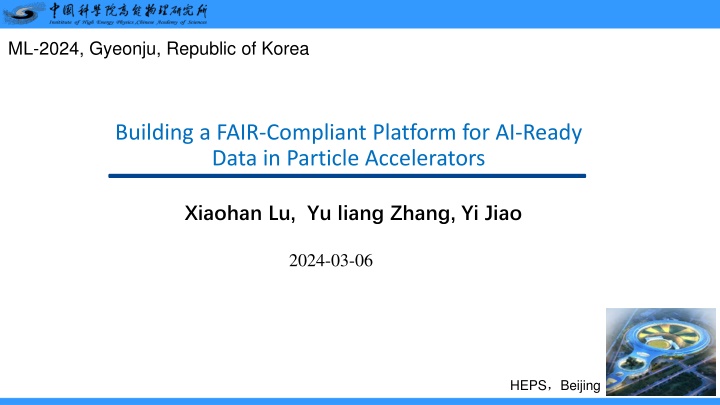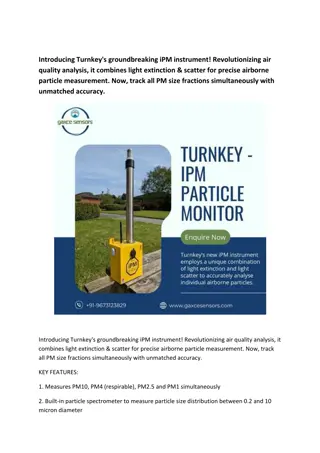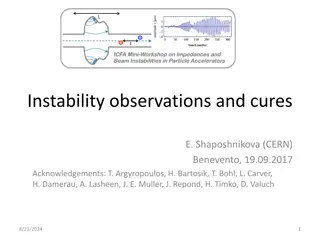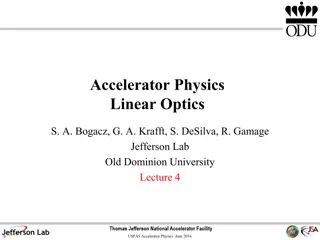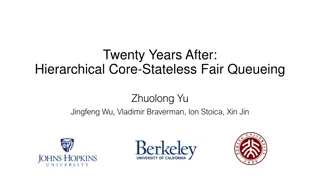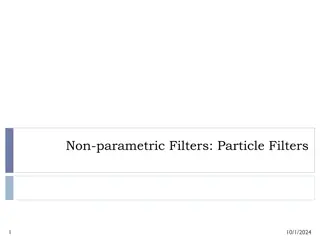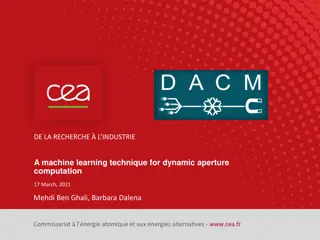Building a FAIR-Compliant Platform for AI-Ready Data in Particle Accelerators
This content discusses the development of a FAIR-compliant platform for AI-ready data in particle accelerators, highlighting the applications of machine learning in various accelerator facilities like CERN, PETRA-III, NSLS-II, HEPS, and more. It emphasizes the importance of high-quality data in accelerating ML applications and suggests solutions to address the data challenges present in particle accelerators. The article also touches upon ML applications in the lab, focusing on optimization, prediction, early warning systems, and beam profile corrections. Overall, it underscores the significance of comprehensive data processing, faster transmission speed, enhanced storage capacity, and standardization of data for successful ML implementation in particle accelerators.
Download Presentation

Please find below an Image/Link to download the presentation.
The content on the website is provided AS IS for your information and personal use only. It may not be sold, licensed, or shared on other websites without obtaining consent from the author.If you encounter any issues during the download, it is possible that the publisher has removed the file from their server.
You are allowed to download the files provided on this website for personal or commercial use, subject to the condition that they are used lawfully. All files are the property of their respective owners.
The content on the website is provided AS IS for your information and personal use only. It may not be sold, licensed, or shared on other websites without obtaining consent from the author.
E N D
Presentation Transcript
ML-2024, Gyeonju, Republic of Korea Building a FAIR-Compliant Platform for AI-Ready Data in Particle Accelerators Xiaohan Lu, Yu liang Zhang, Yi Jiao 2024-03-06 HEPS Beijing
Outline Introduction and Motivation AI-Ready Dataset Building FAIR-Compliant Platform for AI-Ready Data in Particle Accelerators Conclusion
Numerous applications of ML in particle accelerator CERN: Beam Collimation, Equipment Control, Beam Dynamics Analysis PETRA-III: Physics-Based ML NSLS-II: Beam Dynamics Analysis and Optimization HEPS: Nonlinear Dynamics Optimization KARA: High-Frequency Cavity Feedback Control ALS: Bunch Stability Control FANL: Electron Gun Frequency Control SSRF: Physical Information Extraction Based on TBT-Data SLAC: Optimization Design and Feedback Control Based on ML JLAB: Superconducting Cavity Fault Analysis AS: Bunch Length and Energy Jitter Control 3 Yi Jiao, IHEP, jiaoyi@ihep.ac.cn
ML applications in our lab Improvement of numerical optimization based on NN Prediction of DA based on random forests Deep learning based accelerator early warning system ML-based correction of beam profile distortions
The Key for ML application in actual accelerators High-quality data 5
High-quality data problem in Particle Accelerator Applying ML to uncover hidden correlations among machine parameters in research, we need: More comprehensive data processing approach Faster transmission speed Enhanced storage capacity Standardize, categorize, and label the data as early in process as possible Ensure data is synchronized at the appropriate frequency Data in accelerator is typically stored in heterogeneous or temporary formats. Some subsystem may stored data on local disks or at low frequencies, or not store data at all. ML-2018 Edelen, A. et.al., (2018). Opportunities in Machine Learning for Particle Accelerators. arXiv:1811.03172. 6 Yi Jiao, IHEP, jiaoyi@ihep.ac.cn
AI-Ready Dataset in other fields NASA Solar Dynamics Observatory Dataset Electricity Theft Detection Dataset QDataSet: Quantum Dataset Higgs Boson Decay FAIR Dataset 7
High-quality datasets: The key to the success of large models like Pan Gu( ) PanGu accurately predicted the typhoon path, achieving a predication speed 10000 times faster than traditional methods Datasets from 1940 to the present 2000TB Using 60 TB of data for model training. 8
Introduction and Motivation AI-Ready Dataset Building FAIR-Compliant Platform for AI-Ready Data in Particle Accelerators Conclusion
What are the requirements for AI-ready data The Bipartisan Policy Center in the United States specifically discussed this issue at a forum High data quality Detailed metadata Convenient data access Rapid data processing https://bipartisanpolicy.org/explainer/ai-ready-open-data/ 10
FAIR-Compliant AI-Ready Dataset Creating AI-Ready datasets with FAIR principles Accessible via SCPs Metadata remains accessible even if data is unavailable Accurate and detailed descriptions Clear and accessible publishing licenses Accurate information from the data source Findable Accessible Interoperable Reusable The importance of FAIR data Enables powerful new AI analyses Facilitates access to machine learning and predictive data Supports future human-machine collaboration and autonomous machine-to- machine communication Data format is standardized Descriptions must be standardized Unique Identifier Rich Metadata Searchable Wilkinson, M. D. et al. The FAIR Guiding Principles for scientific data management and stewardship. Sci. Data 3:160018 doi: 10.1038/sdata.2016.18 (2016). 11 Yi Jiao, IHEP, jiaoyi@ihep.ac.cn
Fermilab developed a dataset generation system for gradient magnet power supply optimization High praise to this work High praise to this work D. Kafkes and J. St. John, BOOSTR: A dataset for accelerator control systems, Data 6, 42 (2021) 12
Introduction and Motivation AI-Ready Dataset Building a FAIR-Compliant Platform for AI-Ready Dataset in Particle Accelerator Conclusion
A FAIR-Compliant Platform for AI-Ready Data in Particle Accelerators Based on the FAIR principle(Findable, Accessible, Interoperable, Reusable) Develop and establish a comprehensive platform to generate AI-ready Data that meets the requirements for machine learning application. 14
A FAIR-Compliant Platform for AI-Ready Dataset in Particle Accelerator Data Integration Format Selection, e.g. HDF5 Dataset Metadata: Content Description, Creation Data, Methodology, Data Format, Keywords, Access Information, Publishing Institution Data Publishing Data integrity Data synchronization Multimodal database Event-driven data storage Time stamp alignment Metadata: Time, Frequency, Channel Name, Data Type, Data Precision Physical Information: Meaning, Unit, Physical Symbol Data Feature Extraction ML-Model Selection Dataset Training Trained Model Management 15
Multimodal Data Collection Multimodal database, serving as supplements to conventional archiver database, primarily focus on the storage of waveform data, image data, and high repetition rate data. These data need large volumes. For instance, the beam loss monitoring system of the CSNS accelerator generates 41G of waveform data per hour. The multimodal data collection module does not employ a real- time continuous storage approach. It stores data on demand with an event-triggered method. Waveform High-Repetition Rate Image 16 Yi Jiao, IHEP, jiaoyi@ihep.ac.cn
Data Acquisition and Storage Device-level Data Caching: Ensuring High Temporal Resolution of Data High-Precision Time Synchronization System: Achieves global data acquisition event distribution, ensuring the relevance of the collected data. EPICS 7 Assembling and fully describing the locked data read from devices Kafka Data transmission and caching to reduce the network load. MongoDB+HDF5 Storing metadata and waveform data. HTTP REST Interface Querying, plotting, and downloading multimodal data Data acquisition event distribution 17 Yi Jiao, IHEP, jiaoyi@ihep.ac.cn
Data Synchronization Global timestamp synchronization for the accelerator is achieved through a combination of event-based timing systems and NTP (Network Time Protocol) Systems with configured event receivers Global timing is synchronized through an event-based timing system. For Systems unable to synchronize time using an event-based timing system: Time synchronization can be achieved using NTP or PTP, with real-time deviation calculations to calibrate data timing Timing and real-time deviation calculation based on NTP/PTP Global high-precision timing through an event-based timing system 18 18 Yi Jiao, IHEP, jiaoyi@ihep.ac.cn
Module 2 Data Processing Data should be with rich metadata, such as time, frequency, device, channel name, data type, data precision. Add physical contents to the data, include physical name, meaning, units, and symbols Timestamp alignment for data, filling in missing values, eliminating anomalous data, and labeling the data as necessary Feature extraction from data, such as dimensionality reduction, normalization, standardization, and color histograms for image data. Accurate and detailed descriptions Clear and accessible publishing licenses Accurate information from the data source Data format is standardized Descriptions must be standardized Unique Identifier Rich Metadata Searchable Findable Accessible Interoperable Reusable 19 Yi Jiao, IHEP, jiaoyi@ihep.ac.cn
Module 3 Data Packing and Publishing Packing and Publishing Dataset based on FAIR principle Self-developed platform Packaged into HDF5 Rich Metadata With DOI as identifier With CC license Access with http query download Zenodo platform Clear and accessible publishing licenses Unique Identifier Rich Metadata Searchable Access with SCPs Metadata remains accessible Data format is standardized P.S. Zenodo is an internationally general platform for publishing dataset and related research outcomes, operated by CERN Findable Accessible Interoperable Reusable 20 Yi Jiao, IHEP, jiaoyi@ihep.ac.cn
Module 4 Dataset validation and model management Building a one-stop machine learning management platform, ML4ACC, to provide management and access to hyperparameters and models, thereby increasing the degree of automation in the model training workflow Logic Define Hyperparameters Stoping Criteria ML4ACC ML Training workflow Train Dataset Process Dataset Label Samples 21
What we have done Developed a data system for the CSNS accelerator using EPICS7, Kafka, Docker, and HDF5, handling data acquisition, storage, and access synchronized with the 25Hz beam cycle MEBT Vs DTL CT Waveform 2.5ms -1ms Time stamp difference between MEBT and DTL for a single trigger
Introduction and Motivation AI-Ready Dataset Building FAIR-Compliant Platform for AI-Ready Data in Particle Accelerators Conclusion
Conclusion High-quality data is a key element in ML applications and the basis of all research We are dedicated to developing a FAIR-Compliant platform to generate AI-Ready datasets. We have currently completed part of the data synchronization experiments. Thanks for your attention! Any questions or suggestions: luxh@ihep.ac.cn
backup 25 Yi Jiao, IHEP, jiaoyi@ihep.ac.cn
